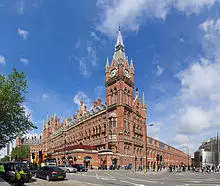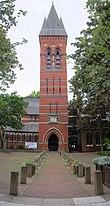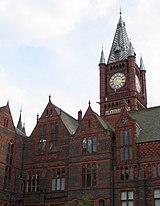
High Victorian Gothic was an eclectic architectural style and movement during the mid-late 19th century.[1] It is seen by architectural historians as either a sub-style of the broader Gothic Revival style, or a separate style in its own right.[2]
Promoted and derived from the works of the architect and theorist John Ruskin, though it eventually diverged, it is sometimes referred to as Ruskinian Gothic.[3] It is characterised by the use of polychrome (multi-colour) decoration, "use of varying texture", and Gothic details.[4] The architectural scholar James Stevens Curl describes it thus: "Style of the somewhat harsh polychrome structures of the Gothic Revival in the 1850s and 1860s when Ruskin held sway as the arbiter of taste. Like High Gothic, it is an unsatisfactory term, as it poses the question as to what is 'Low Victorian'. 'Mid-Victorian' would, perhaps, be more useful, but precise dates and description of styles would be more so."[5]
Among the best-known practitioners of the style were William Butterfield,[6] Sir Gilbert Scott,[7] G. E. Street,[8] and Alfred Waterhouse. Waterhouse's Victoria Building at Liverpool University, described by Sir Charles Reilly (an opponent of Victorian Gothic) as "the colour of mud and blood",[9] was the inspiration for the term "red brick university" (as opposed to Oxbridge and the other ancient universities).[10]
In the 1870s, the style became popular for civic, commercial, and religious architecture in the United States, though was uncommon for residential structures.[11] It was frequently used for what became the "Old Main" of various schools and universities in the late 19th century United States.[4] The Stick Style is sometimes considered the wooden manifestation of the High Victorian Gothic style.[12]
Examples
- United Kingdom
- All Saints, Margaret Street, London. Butterfield, 1849–59
- Church of St James, Baldersby, Yorkshire. Butterfield, 1856–58
- Manchester Town Hall. Waterhouse, 1863–77
- Albert Memorial, London. Scott, 1872
- Royal Courts of Justice, London. Street, 1873–82
- No.s 2-7 Arden Street, Stratford upon Avon.[13]
- The Kirna, Walkerburn, Scottish Borders, 1867[14]
- United States
- Hudson River State Hospital, Poughkeepsie, New York
- Jefferson Market Courthouse, New York, New York
- Memorial Hall (Harvard University), Cambridge, Massachusetts
- New Haven City Hall and County Courthouse, New Haven, Connecticut
- The Miller School of Albemarle, Albemarle County, Virginia (1878-1884)
- Anderson Hall (Manhattan, Kansas), Kansas State University
See also
Notes
- ^ Campbell, Gordon. "Victorian style", The Grove Encyclopedia of Decorative Arts, Oxford University Press 2006. accessed 22 June 2012 (subscription required)
- ^ McAlester, p. 198
- ^ Garrigan, Kristine Ottesen. "'Ruskinian Gothic: The Architecture of Deane and Woodward, 1845–1861' by Eve Blau", Journal of the Society of Architectural Historians , Vol. 42, No. 1 (March 1983), pp. 78–80 (subscription required)
- ^ a b Browning, pp. 300–301
- ^ Curl, James Stevens. "High Victorian", A Dictionary of Architecture and Landscape Architecture, Oxford University Press 2006, Oxford Reference Online, accessed 22 June 2012 (subscription required)
- ^ Crook, J. Mordaunt. "'William Butterfield' by Paul Thompson", The English Historical Review , Vol. 89, No. 350 (January 1974), pp. 131–133 (subscription required)
- ^ Stamp, Gavin. "Sir Gilbert Scott's 'Recollections'", Architectural History , Vol. 19, (1976), pp. 54–73 (subscription required)
- ^ Stamp, Gavin. "High Victorian Gothic and the Architecture of Normandy", Journal of the Society of Architectural Historians , Vol. 62, No. 2 (June 2003), pp. 194–211 (subscription required)
- ^ Powers, p. 1
- ^ The term was coined by Edgar Allison Peers, professor of Spanish at Liverpool University, writing under the pseudonym "Bruce Truscot"; in Redbrick University, 1943, he compares two fictional universities called Redbrick and Oxbridge. See: Oxford English Dictionary, "red brick, n. and adj.", OED Online. June 2012. Oxford University Press, accessed 22 June 2012 (subscription required))
- ^ McAlester, p. 200
- ^ McAlester, p. 256
- ^ Bearman, Robert (1988). Stratford-upon-Avon: A History of Its Streets and Buildings. Hendon Publishing Co Ltd. p. 10.
- ^ "THE KIRNA, B8323". Historic Environment Scotland. Retrieved 27 December 2018.
References
- Brownell, Charles (ed) (1992). Making of Virginia Architecture. Charlottesville: Virginia Museum of Fine Arts. ISBN 978-0917046346.
- McAlester, Virginia; Lee McAlester (1984). A Field Guide to American Houses. New York: Alfred H. Knopf. ISBN 978-0394739694.
- Powers, Alan (1996). "Liverpool and Architectural Education in the Early Twentieth Century". In Sharples, Joseph (ed.). Charles Reilly & the Liverpool School of Architecture 1904–1933. pp. 1–23. ISBN 978-0853239017.

